Matt Reynolds
Today, my family gathered together to celebrate my younger brother’s birthday. With my son, family gatherings usually involve every fawning over him while he’s mostly interested in playing with Cosmo:
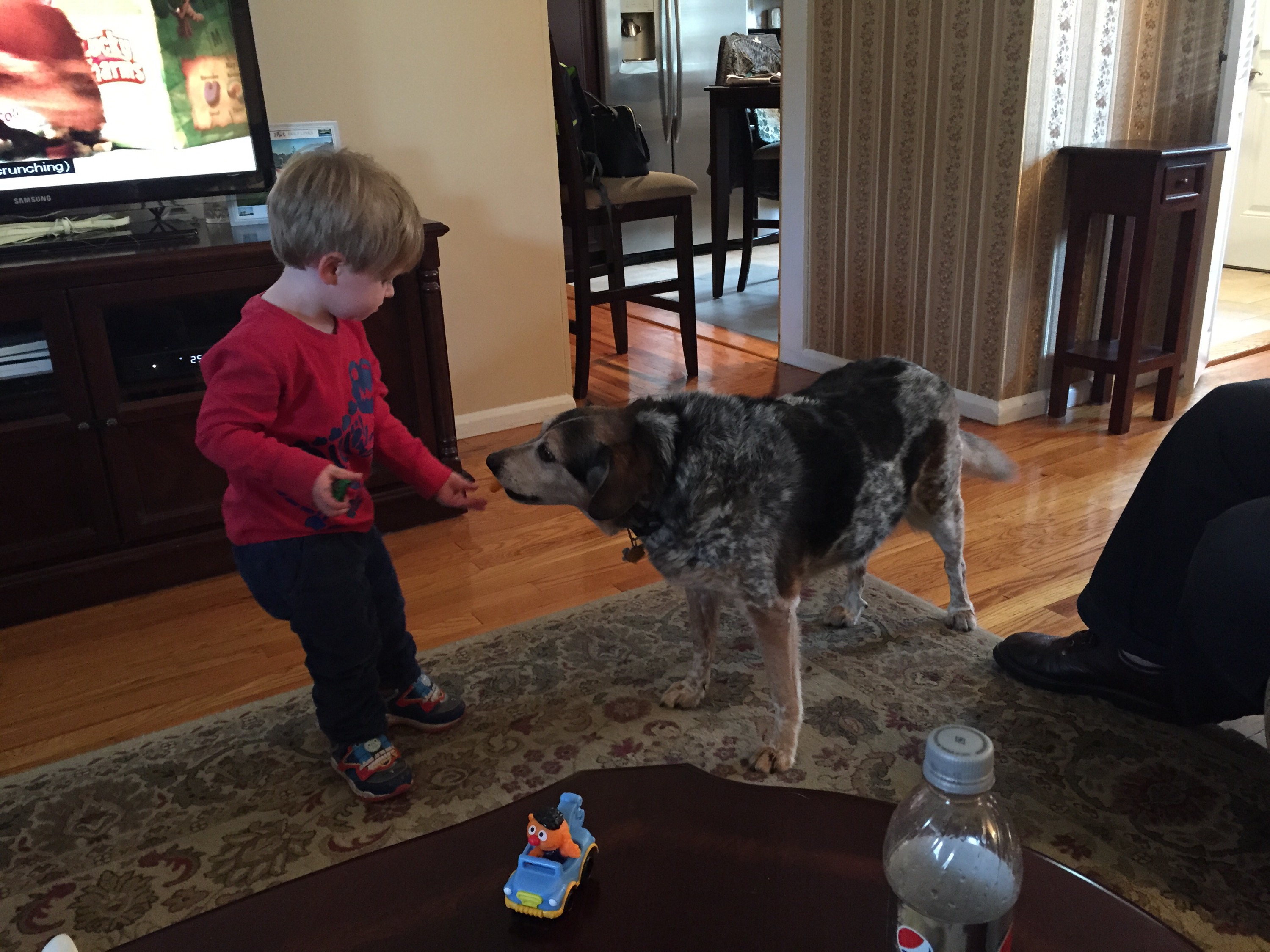
It also means that I get to watch a Mets game with my Dad, brother, and son. My Yankee fan uncle was also there. We get to have all those little conversations about each and every player and what the Mets should or shouldn’t do in each situation. Some major points of discussion:
- Why was Jacob deGrom getting pulled after only 100 pitches?
- How good is Yoenis Cespedes?
- Do you think David Wright‘s career is effectively over?
- Why is Eric Campbell on the team?
- Should Kevin Plawecki or Matt Reynolds bunt?
It was fun having these and other little discussions during the game. It was also fun being in a room of people that universally agreed Daniel Murphy is a better baseball player than Neil Walker. Admittedly, some of these discussions were a bit disjointed with a two year old chasing a puppy and asking questions about the game.
It was great to watch a Mets game with my family the way I grew up watching a games. Sure, we have these discussions over texts during games, but it’s much better having these conversations in person. It’s even better when a game ends with Wright setting a club record with his eighth walk-off hit and ninth walk-off RBI:
The look of a #WalkOff. pic.twitter.com/Q1kE6Gq9A5
— New York Mets (@Mets) May 22, 2016
After the game was over, it was time for some cake and ice cream to celebrate a birthday . . . and a Mets win.
Right now, the Mets are in a prolonged offensive slump. It seems like every Met not named Yoenis Cespedes is having problems at the plate. Here’s how bad things are. Here are the triple slash lines for every Mets infielder (except Matt Reynolds) since the West Coast trip began:
- .176/.300/.235
- .227/.320/.273
- .152/.243/.273
- .129/.325/.258
- .200/.250/.267
- .235/.278/.294
Look at this list. Now, go and pick out which player is Eric Campbell. No, it’s not all Campbell. Yes, those are the real stats. Yes, each of the Mets infielders has been presented in that grouping. Take a look again and pick out which one is Eric Campbell.
The answer is number 2.
The other players were Lucas Duda (#1), Neil Walker (#3), David Wright (#4), Wilmer Flores (#5), and Asdrubal Cabrera (#6).
Campbell’s numbers are not too far off his career slash line of .230/.319/.321. What’s interesting about that is every Mets infielder is hitting like Eric Campbell right now. Not surprisingly, Eric Campbell is the best version of himself. Since the West Coast trip, Campbell is second among Mets infielders in batting average, OBP, and slugging.
He’s even added a few nice defensive plays. He had the diving stop at third for the final out of the game on Mother’s Day. He made two nice defensive plays at first last night including robbing Daniel Murphy of an extra base hit in what was then a tied game. So no, Eric Campbell isn’t the problem. He’s performing about as well as you can reasonably expect the last man on your bench to perform.
No, the problem is everyone on the Mets infield is performing like they’re Eric Campbell.
We can all talk about the Mets striking out too much. We can talk about their supposed over reliance on the homerun. We can talk about their problems hitting with RISP. We can talk about all of that at length. However, we first need to find out how the Mets entire infield hits like Eric Campbell now.
There is no such thing as a bad time to get called-up to the majors. Everything about the majors is better. The money. The travel. The women have long legs and brains. Mostly, it’s what you’ve worked for your entire life.
You don’t want to blow your shot. It’s why now may not be the best time for Matt Reynolds to get called-up.
In Reynold’s last 10 games, he’s hit .175/.214/.275 with no homers and four RBI. He has struck out 15 times. That means Reynolds has struck out 37.5% of the time over his last 10 games. He’s 0-1 in stolen base attempts. After this slump, Reynolds is now hitting .238/.303/.369. Simply put, Reynolds has not played well enough to earn a promotion.
However, he’s getting the promotion because it’s a numbers game. Wilmer Flores is on the DL, and the Mets need a reserve infielder that can play second, third, and short. Reynolds is the only minor league player on the Mets 40 man roster who can do that. So now with Reynolds playing the worst ball he ever has, he’s getting called up.
This is his shot to impress. Considering who the Mets manager is, he’s going to have to impress if he’s going to have a future with the Mets.
Terry Collins has some shortcomings as a manager. The first is he typically relies heavily upon his veterans. The second is that he’s quick to put players in his doghouse. We’ve seen it this season with Collins potentially dangerous use of Jim Henderson rather than using Rafael Montero.
Montero has been in Collins’ doghouse for being injured last year and not pitching effectively this Spring Training. Collins only used Montero when he absolutely had to use him and no more. Montero didn’t produce in his limited chances, and he moved into Collins’ doghouse.
Right now, Reynolds is scuffling. He’s going to get very limited chances, especially with six of the next nine against the Nationals. When Reynolds does get his shot, it’s going to leave a huge impression with his manager. If he gets a basehit, Collins may be inclined to use him more. If he doesn’t get hits, Collins will bury him on the bench. If and when he’s recalled, Collins will again bury him on the bench.
Whether it’s fair or not, Reynolds’ performance will have a big impact on the rest of his Mets career. With the way he’s been playing lately, this chance could not have come at a worse time.
Yesterday’s 0-3 with a strikeout certainly isn’t going to help his cause.
Editor’s Note: this was first published on metsminors.net
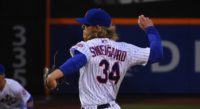
Tonight promised to be a pitcher’s duel, and it did not disappoint. The difference in the game was Max Scherzer made two mistakes and Noah Syndergaard made none.
Curtis Granderson took the first pitch from Scherzer, and he homered to right. Scherzer would be careful with Granderson the rest of the game. Granderson would finish the night 2-2 with a run, RBI, the aforementioned homerun, and two walks. It appears that Granderson is breaking out of his May slump.
The Mets needed it too. Before the first pitch, the Mets discovered neither Lucas Duda or David Wright would be available. Wright’s back flared up necessitating he sit. Duda’s own back issues re-emerged requiring him to receive an injection and sit. In their stead, Eric Campbell and Matt Reynolds manned the corners. It was Reynold’s major league debut. He played third, batted ninth, and wore Wright’d glove. Campbell and Reynolds each went 0-3. Campbell struck out twice, and Reynolds struck out once.
It was a lineup reminiscent of last July. Like last July, Granderson provided the offense. Like last July, Michael Conforto came to the rescue. In the third, he homered to right to make it a 2-0 game. Syndergaard did the rest.
Syndergaard pitched seven innings only allowing five hits, no earned, and no walks while striking out 10. He had the pitches coming in at 100 MPH. Before the game, Bryce Harper said at the ESPN Upfront event he was curious as to what would happen against the 100 MPH fastball. The answer was an 0-3 night with two strikeouts against Syndergaard.
Aside from the two mistakes, Scherzer matched Syndergaard pitch for pitch. He allowed three hits, two earned, and three walks while striking out 10. He did all he could do, but he didn’t get much help from anyone other than Daniel Murphy.
It was Murphy’s first game back at Citi Field since signing with the Nationals in the offseason. In the first inning, he made a sparkling defensive play robbing Campbell of a hit:
Daniel Murphy knows this Citi pretty well: https://t.co/adZAVppFSs pic.twitter.com/Ti2okeEWOq
— MLB GIFS (@MLBGIFs) May 17, 2016
After that play, Murphy would get his first official at bat against the Mets. Before the at bat, Murphy would get a well deserved ovation:
Murphy would foul out to third. Before his next at bat, he would be booed. Murphy responded by dropping a single over the head of his replacement, Neil Walker. Overall, Murphy would go 1-3 dropping his batting average from .400 to .399.
Despite Murphy’s and Scherzer’s efforts, the Mets shut down the Nationals. Addison Reed and Jeurys Familia came on and slammed the door shut. The Mets won 2-0, took sole possession of second place, and moved within a half-game of the Nationals. The Mets can take over first place with a win tomorrow.
Game Notes: Kevin Plawecki had a nice game going 1-3 and throwing out Ben Revere trying to steal a base. It was only the fourth runner in 33 attempts thrown out while Syndergaard was on the mound. Of course, Oliver Perez entered the game and got his only batter out. Here was the Mets pregame video tribute to Murphy:
Thank you, Murph!https://t.co/bna7xfzZWX
— New York Mets (@Mets) May 17, 2016
At what point does T.J. Rivera finally get his shot?
In his minor league career, Rivera has hit everywhere he’s gone. In his minor league career, he’s hit .320/.367/.423. For the past three years, he’s played Winter Ball hitting .307/.361/.445. Bottom line is Rivera has hit everywhere he has played in his entire minor league career. He had gotten better each and every year. For example, he’s hitting .330/.360/.524 in Triple-A right now.
Even with Rivera hitting so well and improving, it seems like the undrafted 27 year old may never get his shot.
He didn’t last year. The Mets were more comfortable with a struggling Dilson Herrera. They were more comfortable with Danny Muno. They didn’t protect him in the Rule 5 draft despite his offensive production. The Mets were able to keep him because no one thought he was worthy of a Rule 5 pick. Seeing what the Braves put on the field, it makes you question what are we missing with Rivera?
There is a tendency to scout a player’s minor league statistics. The belief is that if a player can hit in the minors, they can hit in the majors. The inverse of that is deemed to be true as well. However, there are many more factors at play like level of competition, approach at the plate, level of experience and age compared to the competition, etc. When taking a totality of the circumstances, a player who hits well in the minors but isn’t deemed good enough to hit in the majors is tagged as a AAAA player.
Is that the case with Rivera? Is he really just a AAAA player? That would be the most logical explanation as to why he still hasn’t gotten his shot.
To answer that, we need to look at what he is. Rivera is a utility player that can play second, third and short. In reality, given his range and arm strength, he’s best suited to second base. Overall, no matter where you play him, he’s not that great defensively. Despite his relative versatility, it’s Rivera’s bat that would carry him to the majors.
As discussed above, Rivera has hit everywhere. There’s good reason for that. He’s a disciplined hitter. He has a good compact swing, and he’s a gap to gap line drive hitter. He doesn’t generate much power, but he’s capable of the occasional double. In short, Rivera shows the skills to be able to get on base no matter what the level.
What we don’t know if that ability will ever translate. At the major league level, the Mets have Wilmer Flores and Eric Campbell. Campbell, in particular, is what Rivera aspires to be. Campbell can play a multitude of positions. He doesn’t generate much power, but he has shown the ability to get on base. So long as Campbell gets on base, the Mets aren’t sending him down.
In the event Campbell ever gets sent down, it’s highly unlikely Rivera ever gets the call. He’s buried at the upper levels of the Mets minor league system behind guys like Herrera, Matt Reynolds, and Gavin Cecchini. Worse yet, Rivera isn’t on the 40 man roster thereby further decreasing his chances of ever getting a shot.
Unfortunately, it appears Rivera may never get his shot with the Mets. He may never get an opportunity to show he has the tools to hit and get on base in the major leagues. It’s a testament to a deep Mets farm system. It’s an indictment of the rest of baseball, who apply AAAA tags to players without ever giving them a chance that they’ve earned.
T.J. Rivera has earned a shot to play in the major leagues. Hopefully, he will get that shot someday.
Editor’s Note: this was first published on metsminors.net
Given the Mets offseason moves and roster construction, a lot was going to be asked of Wilmer Flores. He had to be the main backup at all four infield positions. He had to learn first base. He had to be the power bat off the bench. He had to be a platoon option at second base in the event Neil Walker continued his career struggles against lefties. He had to be the Mets insurance for David Wright‘s back.
So far this year, Flores is hitting .159/.229/.273 with an OPS+ of 36 and a wRC+ of 39. His main issue is he can’t hit the fastball. Even worse, he’s not hitting breaking balls. Overall, he’s just not hitting. Put if this way: he has as many homeruns as Bartolo Colon.
He’s also not fielding. According to UZR and DRS, he’s only played well at first and short. He’s struggling with his throws from second and third. He’s not good at the plate. He’s not good in the field. He’s a -0.4 WAR player thus far. He’s having a nightmare of a season. He’s failing miserably.
Worse yet, the Mets need him.
Wright’s stenosis isn’t going away. Walker hasn’t hit lefties his entire career. Neither has Lucas Duda. The Mets need Flores to play for one of them at least once a week. When he’s not starting, Flores is the Mets lone power bat on the bench. He’s an important player on the team. So far, he’s not up to the challenge.
The only thing saving him is he has no options left. This means players like Matt Reynolds and T.J. Rivera will stay in the minors despite having earned a call-up. Instead, Eric Campbell, who is coming off a good game, may need to play more. Until Flores figures it out, Campbell may be the Mets best infield option. No one planned on that happening.
No, the plan was for Flores to play an important role. For now, Flores still has that role. However, if he continues playing this poorly that role is going to have to someone else. That switch may need to happen sooner rather than later.
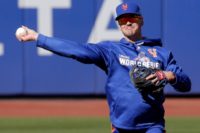
Due to the stress Jacob deGrom‘s injury and Steven Matz‘s short start out on the bullpen, the Mets were forced to call-up Rafael Montero to add a fresh arm to the bullpen. Rather than out deGrom on the DL or demote another pitcher, the Mets sent down Eric Campbell. Even with deGrom looking more and more like he will miss his next start, the Mets still won’t put him on the DL. Essentially, the Mets robbed Peter to pay Paul.
With a weekend Interleague series in Cleveland, the Mets can get away with a short bench. While it does limit their ability to pinch hit and make defensive substitutions, they should be able to navigate the situation because they won’t have to pinch hit for a pitcher. However, come Monday, they’re back to playing National League ball, and they’re going to need a full bench.
Whatever your feelings on Campbell is, he’s not going to be eligible to be recalled. Unless deGrom (or someone else) goes on the DL, Campbell will have to spend 10 days in the minors. Looking over the Mets 40 man roster, there would be three eligible candidates: Dilson Herrera, Matt Reynolds, and Brandon Nimmo. Now with one extra spot left on the 40 man roster due to Zack Wheeler being on the 60 day DL, the Mets could recall another player like a Ty Kelly.
In reality, the decision is between Reynolds and Kelly. Nimmo isn’t quite ready, and even if he was, the last thing the Mets need is another outfielder. Herrera still hasn’t started playing games in the field yet due to a sore shoulder, and even if he has been, the Mets see him as the second baseman of the future. They’re not wasting service and development time for him to be on the bench.
Kelly is 27 years old, and he has yet to play in the majors. He plays second, third, and the corner outfield positions. He’s a very disciplined hitter, who is extremely selective at the plate. For reasons that aren’t completely clear, he’s spent five seasons in Triple-A, and he’s never played a major league game. Overall, the truth really is Triple-A is his ceiling. At best, he’s a AAAA player.
Even if that assessment was wrong, it’s still not time to call-up Kelly. First, the Mets would have to add him to the 40 man roster and would not be able to denote him unless he clears waivers. Additionally, his skill set doesn’t match what this team needs. There’s no room for him in the outfield. Terry Collins is going to play Neil Walker almost everyday. So in essence, while Kelly has some versatility, the positions he plays do not match the Mets’ needs.
Accordingly, Reynolds is the player the Mets need to recall. During Spring Training and this early minor league season, Reynolds has played every infield position but first. His addition to the major league roster would create more flexibility across the infield. It would permit Collins to sit both Asdrubal Cabrera and Lucas Duda in the same game. Additionally, it would permit Collins to double switch with any player with the full knowledge that there’s another player on the bench who is fully capable of playing any position should another double switch be needed or there was an injury.
Offensively, Reynolds is a right hand batter who profiles better at the next level than Kelly. He’s not as patient as Kelly, but then again no one is. Reynolds profiles as a gap to gap line drive hitter. He does have more pop in his bat than Kelly. More importantly, at the very least, Reynolds projects as a bench player.
If Reynolds is going to wear a Mets uniform past smiling and waiving before Game One of the NLCS, he’s going to be a super-utility man in the mold of Flores or Joe McEwing. Reynolds has worked hard at it during the offseason and Spring. He knows this is his future, and he’s fully embraced it.
Better yet, he’s scorching hot right now. He’s hitting .353/.476/.529 with a homerun in five games. In those fives games, he’s played second, third, and short. At this point the only plausible reason for not calling up Reynolds is the Mets want to have a short bench.
Reynolds has earned his shot, and he’s playing well. It’s time for the Mets to call-up Reynolds.
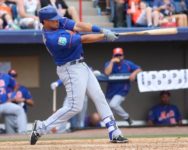
During Spring Training, Travis Taijeron introduced himself to many Mets fans by hitting .368/.432/.658 with two homeruns and 11 RBI. He played so well he was awarded the John J. Murphy Award, which is given to the top rookie in his first ever Spring Training.
It’s somewhat ironic that Taijeron wins that award as the 27 year old’s chances of ever playing for the New York Mets dwindle by the day.
In Taijeron’s major league career, he has only played the outfield. As Mets fans already know, the major league club is saturated with outfielders. In fact, the Mets have two major league caliber starters, Juan Lagares and Alejandro De Aza, as reserves. The Mets major league depth, and the fact that Taijeron is not on the 40 man roster makes it highly unlikely he will get called up to the majors either this year or in subsequent years.
No, in order for Taijeron to put himself into position to ever be called up to the majors, he’s going to have to become a more versatile player. It’s what the Mets are working on now with Taijeron’s AAA teammate Matt Reynolds. It’s a big reason why Eric Campbell made the Opening Day roster. In his short major league career, Campbell has played every position but pitcher, catcher, and centerfield. By the way, Campbell has worked at being capable enough behind the plate to become an emergency catcher.
So, if Taijeron ever wants to play in the majors, he’s got to pick up a first baseman’s mitt. He has to work on the position whenever he can. He needs to show the Mets organization that he is more than just an outfielder. He needs to show them he can be a versatile part of a major league bench. These are the types of things a 27 year old minor league player, who was drafted in the 18th round, needs to do.
Fortunately for him, if he becomes proficient. The Mets have no prospect standing in his way from playing some AAA games at first. The current AAA first baseman is Marc Krauss, who is nothing more than minor league depth. He’s a career .187/.255/.324 major league hitter. There is no scenario in which he ever plays for the Mets.
However, with the way Taijeron hits, he could play in the majors. Last year in AAA, he hit .274/.393/.536 with 25 homeruns and 71 RBI. His season was good enough to earn him an invitation to Spring Training where he made the most of his opportunities. He showed the Mets he has pop in his bat, and he can play the outfield well. Now, he just has to show them he can play one other position.
The Mets organization has some interest in seeing Taijeron play first base. It would permit Reynolds to play some outfield as he tries to become more versatile himself. With respect to Taijeron, the Mets could have a bench bat that can draw walks and hit for some power. As such, putting Taijeron at first would permit the Mets to extract the most value possible out of two prospects. Therefore, allowing Taijeron to play first would be in the Mets’ best interests.
Taijeron has real talent, which may or may not translate to the majors. However, we will never know if it could unless he makes himself versatile enough for the Mets to call him up to the majors. It’s time for Taijeron to put on a first baseman’s mitt.
Editor’s Note: this first appeared on metsminors.net

After the Mets bullpen had to pitch 7.1 innings on Monday with Steven Matz‘s terrible start, and Logan Verrett having to come out of the bullpen to start in place of Jacob deGrom, the Mets were forced to make a move to add a pitcher to the roster.
There were plenty of good options available to them.
The Mets could’ve utilized deGrom’s paternity leave and called up Rafael Montero. However, the Mets didn’t want to do that because they then couldn’t backdate a potential deGrom DL stint to last Saturday. The Mets could’ve just placed deGrom on the DL, but for some reason they do not appear ready to do that. Apparently, that April 19th game against the Phillies is a must win, and you need deGrom to pitch in that game if at all possible.
No, the Mets decided to demote a player. Looking over the roster, the only pitcher who realistically could be demoted is Hansel Robles. He seems like a natural choice as he pitched 2.2 innings on Monday, and he could use an extra day or two. If Montero falters, the Mets could recall Erik Goeddel or Sean Gilmartin to take his place on the roster.
In this scenario, Robles would have to stay in the minors for 10 days unless the Mets put deGrom (or someone else) on the DL. Given Robles’ current role, losing him for 10 days would be palatable. Montero, Goeddel, or Gilmartin could easily be the long man and/or last man in the bullpen.
Instead of the Mets following the reasonable course of action, they determined it was in their best interests to demote Eric Campbell. In essence, the Mets decided to go with the worst possible choice.
Now,there is nothing wrong per se with demoting Campbell. He’s a career .230/.315/.325 hitter. He has good attributes as a player, but nothing that Campbell has done in his career would ever prevent him from being demoted. However, if he’s being demoted, it should be because the Mets are calling up another position player like Matt Reynolds, not because they are adding a pitcher to the roster.
The Mets demoting Campbell for Montero shortens the Mets bench. In a world where you have David Wright on your team, you should never shorten your bench. On any given day, Wright can wake up sore and not be ready to play. If that happens, not only are you down another player, but you also have no infielders on your bench.
By the way, the Mets are playing a day game after a night game. Terry Collins has said there’s no hard-and-fast rule stating Wright must sit a day game after a night game. However, it’s also true that the Mets have so far refrained from playing Wright in a day game after a night game. No one knows how his back will respond to it. No one knows if he will be able to get loose in time to play a full nine innings.
Instead of taking this into account, the Mets thought it would be best to potentially have no infielders on the bench. The Mets thought it would be best to realistically only have two options on the bench for Wednesday’s game (Collins is loathe to pinch hit with his catcher). Also, apparently, the Mets do not foresee the need to have more than two pinch hitters available in a game where the starting pitcher hasn’t pitched in almost a month and wasn’t stretched out in Spring Training. No, the Mets are setting forth a gameplan where they will have Verrett go deep in the game, and they will be alright with just two bench players. What could go wrong?
The Mets are in the midst of a four game losing streak and would rather potentially sacrifice the the last game of the homestand to give themselves the best possible shot of winning a game against a terrible Phillies team in Philadelphia. The Mets apparently didn’t learn their lesson on Monday about the perils of having a shortened roster.
Overall, the Mets put themselves in a tough position all because they’ve deemed an April game in Philadelphia a must win. Why else wouldn’t you put an injured pitcher who is already missing a start and bullpen sessions on the DL?
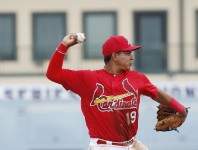
When Ruben Tejada was tendered a contract, I agreed with the move. When the Mets released him, I understood the move. He was taking up a spot on the 40 man roster, and there were important roster decisions to make. Now that Spring Training is over, and the roster is set, I don’t understand the Mets thought process.
Heading into the season, the Mets placed Zack Wheeler on the 60 day disabled list. This frees up a spot on the 40 man roster until such time as Wheeler is back and ready to play. This move coupled with Tejada’s release gave the Mets two open spots on the 40 man roster. With Jim Henderson making the team that leaves one open spot on the 40 man roster. That spot has gone unfulfilled.
The Mets could’ve used it to acquire a backup catcher. Rene Rivera, a strong defensive catcher, is a free agent. The Mets decided to bring back Johnny Monell on a minor league deal despite a tough 2015 season. Apparently, the Mets weren’t happy with their choices or with the choices available because they put Kevin Plawecki on the Opening Day roster. Rather than them using the last spot on the 40 man roster, the Mets decided to allow Plawecki reach Super Two status. They are gambling with hindering Plawecki’s development by not getting him regular playing time.
They are also relying on Wilmer Flores being the primary backup to all four infield positions. They are hoping Eric Campbell can be a good bench player like the front office has always imagined he could be. They are hoping that if he falters, or there is an injury, Matt Reynolds could fill-in. They are taking this risk despite Reynolds not having an obvious position to play in AAA with the presence of Dilson Herrera and Gavin Cecchini.
The Mets knew Tejada could adequately play second, third, and short. His presence could’ve allowed the Mets to let Flores get more time at first and third. For reasons now unknown, the Mets decided not to go this way. The Mets decided not to go with a bona fide major league caliber player to be a utility player even though Tejada arguably had the best year of his career when he started the year as a utility player in 2015.
Instead, the Mets let Tejada go to another National League team. If not for his recent injury, he would be helping the Cardinals try to win a World Series. There was a spot for him to do that with the Mets. Instead, the Mets have decided to let that last 40 man roster spot go to waste.
Upon reflection, the only reason it makes sense for the Mets to release Tejada and for them not to add another catcher is money. By cutting Tejada when they did, the Mets saved about $2.5 million.
The Mets are making cost cutting moves that harms the team’s depth despite tickets sales being much better than the Mets thought it would be. The Mets are paring down payroll despite the Mets slightly raising ticket prices.
Yes, the Mets went out and spent the money on Yoenis Cespedes. Yes, the payroll is more commensurate with what a contending team’s payroll should be. However, releasing Tejada is an unnecessary mickle and dime maneuver. He was depth. After last year’s rash of injuries, you would think the Mets wouldn’t take that lightly. He wasn’t taking anyone’s spot on the roster. In fact, they’re not even using all the spots available to them on the roster.
Hopefully, the Mets season doesn’t come down to a $2.5 million decision the team made in March.
